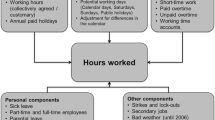Abstract
This paper discusses the role of the indicator of average time worked per employee in assessing current market situation and output growth reserves. This indicator, considered a key one worldwide, is not published in Russia at all (though estimated). Considered are general and specific factors underlying differences in hours worked in different countries and industries, with their dynamics across 20 industries of Russia’s economy in 1959–2004. Output growth reserves due to this indicator are assessed.
Similar content being viewed by others
References
Russian Statistical Yearbook 2004: Statistical Abstract (Rosstat, Moscow, 2004) [in Russian].
E. I. Denison, Why Growth Rates Differ: Post-War Experience in Nine Western Countries (Brookings Inst., Washington, D.C., 1967).
L. Stoleru, Economic Equilibrium and Growth (North-Holland, Amsterdam, 1975).
Additional information
Original Russian Text © N.V. Kozlov, 2006.
Rights and permissions
About this article
Cite this article
Kozlov, N.V. Hours worked and output growth reserves. Stud. Russ. Econ. Dev. 17, 259–266 (2006). https://doi.org/10.1134/S107570070603004X
Issue Date:
DOI: https://doi.org/10.1134/S107570070603004X




